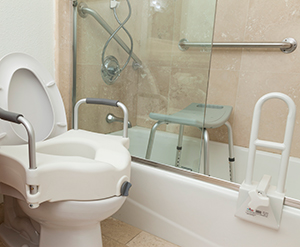A
B
C
D
E
F
G
H
I
J
K
L
M
N
O
P
Q
R
S
T
U
V
W
X
Y
Z
Topic IndexLibrary Index
Click a letter to see a list of conditions beginning with that letter.
Click 'Topic Index' to return to the index for the current topic.
Click 'Library Index' to return to the listing of all topics.
Chronic Lung Disease, Day-to-Day Care: For Caregivers
Chronic lung disease may include COPD (chronic obstructive pulmonary disease), which is chronic bronchitis and emphysema. It also includes pulmonary fibrosis, sarcoidosis, and other long-term respiratory conditions. With chronic lung disease, even getting in and out of bed can be difficult. Coping with the physical limits of these conditions can be a challenge for both your loved one and you. But you can each take steps to keep your daily routine simple.
Living healthier
Try to stay in good health. For instance:
-
Encourage each other to stay active. Think of ways to be active together. You might go for a walk or do some gentle stretching exercises. Or try some chair exercises. For instance, you can lift your legs up and down while sitting.
-
Physical therapy. Your loved one may benefit from physical therapy. Talk with their healthcare provider about it.
-
Pulmonary rehab (rehabilitation). Community-based and home-based programs work as well as hospital-based programs as long as they are held as often and are as intense. Standard home-based pulmonary rehab programs help with shortness of breath in people with COPD. Traditional, supervised pulmonary rehab is the best choice for people with COPD. These programs help manage the disease by helping with breathing methods, exercise, support, and counseling.
Look into programs in your area and encourage your loved one to join them. These programs help those with chronic lung conditions to better deal with their illness and stay as active as possible. To find one, ask the provider or call your local hospital. Also talk with the provider about which rehab or self-management program is best for you.
-
Help each other plan and make meals.
-
Try to choose healthy foods. There are a lot of very unhealthy choices. But there are also healthier versions of most foods. For instance, there are low-fat, low-salt frozen dinners.
-
Your loved one may be limited. But think of ways they can help. Maybe they can sit at the table to cut vegetables.
-
Try to help your loved one stay at their ideal weight or a healthy weight. Being overweight or underweight can affect their health. Being underweight can limit their energy. Being overweight can make shortness of breath worse.
-
Try to manage stress. Talk with your healthcare providers if you're both having a hard time managing stress. Or if you're feeling depressed or anxious. You might try yoga, deep breathing, or meditation. Learning to relax and to breathe more slowly can help both of you. You might also consider seeing a counselor.
-
Get enough sleep. Both of you should try to get enough sleep each night. A short nap may be OK. But too much napping makes it harder to sleep at night. If symptoms are making it hard for your loved one to sleep, talk with their healthcare provider.
-
Practice correct handwashing to prevent illness. Infections like a cold or the flu can make breathing more difficult. Wash your hands often with soap and clean, running water. Use hand sanitizer when you can’t wash your hands. Also, stay away from crowds during cold and flu seasons.
Making living spaces safe
Even a few changes can make your home safer. Try these tips:
-
Get help. Therapists can help you with home safety issues. Talk with your healthcare provider about home physical and occupational therapy.
-
In the bathroom, make changes to the shower or tub for safety. Get a waterproof stool and handheld water nozzle. Install grab bars to make getting in and out easier. Use only nonslip bathmats or rugs.
-
In the kitchen, make sure items that you use often are within reach. This includes dishes and silverware. Keep these items as close to counter height as possible. Bending or reaching for items can cause injuries to your loved one.
-
Make sure floors are safe all through the house. And remove small rugs to prevent tripping. Make sure all areas are well lit. Install grab bars and handrails.
 |
| A waterproof stool and grab bar make the shower safer. |
If you or your loved one smokes
Smoking makes symptoms worse and harms health. If either of you smokes, it’s time to stop. Talk with a healthcare provider to learn about local smoking cessation programs. Also try the following:
-
Make a list of reasons to quit. Keep the list handy and read it often.
-
List the places, feelings, and things that make you want to smoke. Think of ways to avoid them.
-
Think about what you can do instead of smoking. Again, make a list. Then use one of the items on the list if you want to smoke. For instance, you might go for a walk, call a friend, or chew a piece of sugarless gum.
-
Ask your healthcare provider or pharmacist about medicines to help you stop smoking. Some are available over-the-counter. Others need a prescription.
-
Find help quitting smoking at the American Lung Association at www.lung.org/quit-smoking or 800-LUNG-USA (800-586-4872).
Online Medical Reviewer:
Chris Southard RN
Online Medical Reviewer:
Jessica Gotwals RN BSN MPH
Online Medical Reviewer:
Rajadurai Samnishanth Researcher
Date Last Reviewed:
9/1/2024
© 2000-2025 The StayWell Company, LLC. All rights reserved. This information is not intended as a substitute for professional medical care. Always follow your healthcare professional's instructions.